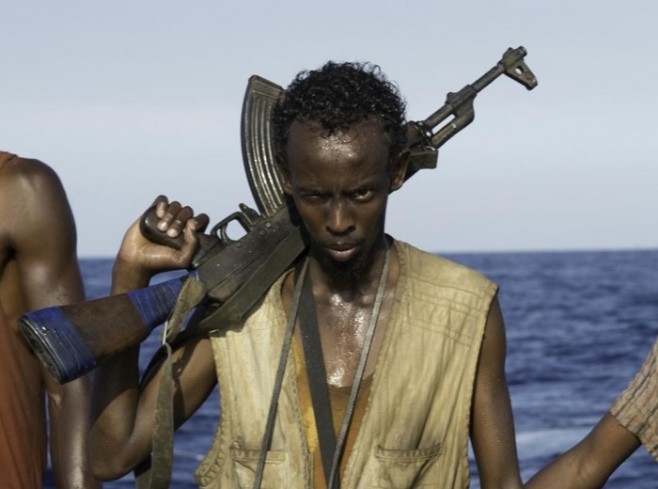Djibouti (HAN) March 28, 2014 – Despite dangers portrayed in Captain Phillips, pirate attacks in Somali waters have declined drastically. It’s a different story in Strait of Malacca.
The thriller Captain Phillips, focused on Somali pirates, but pirate strikes in Somali waters have plummeted. There were only seven incidents in 2013, all unsuccessful.
Opinion By: Patrick Winn Globalpost,BANGKOK— Maybe God has a soft spot for pirates. That would explain the Strait of Malacca, a natural paradise for seafaring bandits.
Imagine an aquatic highway flowing between two marshy coasts. One shoreline belongs to Malaysia, the other to Indonesia. Each offers a maze of jungly hideaways: inlets and coves that favour pirates’ stealth vessels over slow, hulking ships.
It’s a narrow route running 885 kilometres, roughly the distance between Miami and Jamaica. This bottleneck is plied by one-third of the world’s shipping trade. That’s 50,000 ships per year — ferrying everything from iPads to Reeboks to half the planet’s oil exports.
The world’s fascination with neo-piracy now centres on Somalia. Thanks to the 2013 thriller Captain Phillips, in which Tom Hanks plays a cargo ship captain abducted by Somalis, even teenagers know the anarchy-prone African state is a breeding ground for pirates.
At least it was. In truth, Hollywood stumbled onto Somalia’s piracy phenomenon rather late. In the last three years, pirate strikes in Somali waters have plummeted 95 per cent to a meagre seven incidents in 2013; none were successful.
Piracy in Southeast Asia, meanwhile, is accelerating. Attacks and attempted attacks in the waters of Indonesia — which controls much of the Malacca Strait and its environs — totalled 107 last year. That’s a 700 per cent increase in just five years.
The German insurance firm Allianz, which released these figures in a new report, is now sounding a warning: Southeast Asian piracy must be reined in before it’s too late.
The attacks mostly amount to “opportunistic thefts carried out by small bands,” according to Allianz, but these syndicates could potentially “escalate into a more organized piracy model.”
Modern-day captains plying risky waters look to a guide called the BMP. Based on intel from Western navies and shipping firms, it offers tactics on avoiding pirates and — if that doesn’t work — fending them off and surviving abduction.
The guide’s best advice? Go really fast. No pirates have ever boarded a ship pushing 18 knots, or nearly 34 kilometres per hour, the guide says.
But that’s practically impossible in the Strait of Malacca.
The channel is simply too crowded and too shallow. Gigantic vessels are instead forced to churn through at slow speeds that invite pirates in fast-moving skiffs. (To save fuel, today’s cargo ships often travel at about 22 kilometres per hour.)
Indonesian pirates typically have different tactics from their Somali counterparts, who’ve made headlines by invading vessels and demanding multimillion-dollar ransoms.
In the Malacca Strait, pirates like to get in and get out. Their “modus operandi isn’t to kidnap,” according to Tim Donney, an Allianz marine risk consultant. “These pirates just want the cash aboard the vessel or to rob the crew of any valuables.”
Indonesia isn’t nearly as lawless as Somalia. But both are coastal nations where poverty is rife and police are ill-equipped. Both also happen to be situated on routes trafficked by wealthy nations’ trade vessels.
“Most piracy takes place in areas where people are poor. Their livelihood has been taken from them by globalization, civil unrest or war,” writes Nigel Cawthorne, author of the book Pirates of the 21st Century.
Somalia’s turnaround is owed to several factors: NATO- and EU-backed naval patrols, ships hiring on-board riflemen and, perhaps most importantly, a new Somali government working to stabilize its lawless coast.
Somali pirates also forced the shipping industry to get creative. They’ve come up with effective pirate-proofing techniques that could be applied to more ships entering the Malacca Strait.
The BMP recommends blasting approaching pirates with hot water, ringing ships with razor wire and even installing electric fencing. Discharging foam, according to the manual, is “effective as it is disorientating and very slippery.”
Piracy along the Malacca Strait route should be easier to fight than in Somalia. All of the nations patrolling the strait have functioning governments, committed to fighting the problem, and are financially incentivized to maintain a bandit-free trade route.
Piracy poses no existential threat to the shipping industry. Considering the volume of international trade, losses from piracy “amount to little more than a rounding error,” according to piracy analyst Martin N. Murphy. But the “sense of disorder” created by piracy, he writes, “may be hard to calculate in dollars.”
Video: The Kenyan Somali Parlimaterian farah moalim vs Amb Ali America : A heated exchanges
–
HAN & Geeska Afrika Online (1985-2014), The oldest free independent Free Press in the region, brings together top journalists from across the Horn of Africa. Including Ethiopia, Somalia, Eritrea, Sudan, Djibouti, South Sudan, Uganda, Kenya, Oromo, Amhara, Somali, Afar and Harari. Plus, we have daily translations from 150 major news organizations in the Middle East and East African regions. Contact at news@geeskaafrika.com
–
Have you been affected by this story? You can share your views and experiences with us using this form: HAN@geeskaafrika.com


Leave a Reply